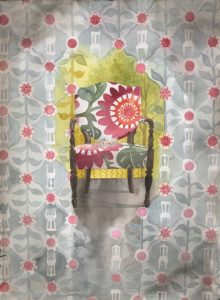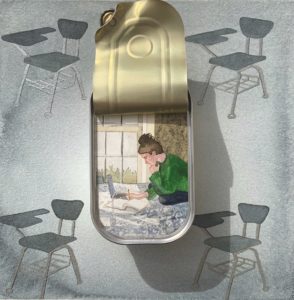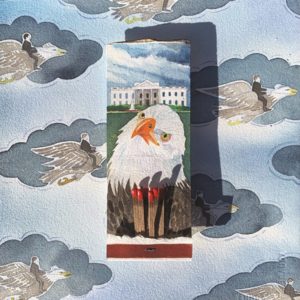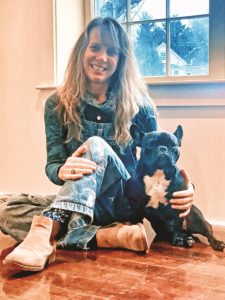“My work is always telling a story,” says Traci Harmon-Hay. Pieces from her new series, “Hovering Boats,” will be exhibited from May 24 to June 17 at Farm Projects in Wellfleet. The show, titled “Tethered,” examines our relationship to the oceanic ecosystems surrounding us and invites the viewer to contemplate deeper themes of connection and loss.
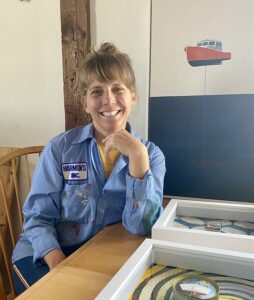
In Harmon-Hay’s paintings, unpeopled working boats hover above an ocean, tethered to the water by a rope represented by a piece of string sewn into the canvas. The starkness of the rope line and the white space in which the vessel floats directs the viewer’s eye straight to the object itself. The atmosphere is one of mystery, lightness and grounding.
“There’s a layer of ambiguity that encourages the mind and heart to wander,” says Farm Projects curator Susie Nielsen of Harmon-Hay’s art. “Each piece invites viewers to delve into a realm where the ordinary meets the extraordinary, prompting reflection on the intricacies of life and human experience.”
Harmon-Hay says she doesn’t want to impose the personal stories behind her work on viewers. “I want the viewer to look at these pieces, wonder, and come up with their own feelings and conclusions,” she says. “The feeling hovering, landing, or floating away is decided by each viewer’s experiences.”
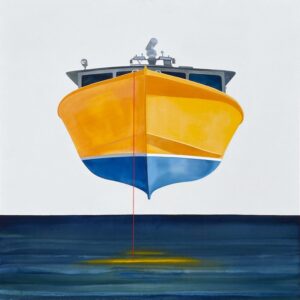
To Harmon-Hay, the rope that tethers the boats in her paintings to the water represents connection as well as control. “There are so many ways we are tethered,” she says, “to our children and families, to our homes, our surroundings, and the objects that sustain us. And sometimes we’re tethered to things that maybe we shouldn’t be.”
Objects lie at the heart of Harmon-Hay’s work. Each series looks closely at familiar objects — boats, houses, matchbooks, cans, tea bags — and represents a particular time in the artist’s life. “When I look back,” she says, “I see the chapters of my life in my work. When I did the tea bags, for example, I was steeping as an artist. I was losing myself raising two babies. My matchboxes and matchbooks are linked to a difficult time in my life.”
Harmon-Hay developed the idea for her current series on recent trips to coastal Maine. Like her “Floating Houses” series, which was inspired by the housing shortage on the Cape, her hovering boats are linked to Earth’s environmental crisis and the state of the fishing industry.
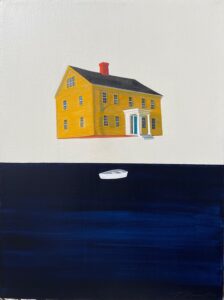
“On our journeys north, I noticed many massive, beautiful working boats out of the water, in dry dock,” she says. “I was moved to create these pieces while watching what is happening all down the coast and here in our own waters. A lot is changing. The catch is down, the waters are warming, the lobsters are moving. Regulations are changing. It’s a tough industry with a lot of danger in it. These boats are very important objects in people’s lives. They provide strength and shelter to go out into the ocean and sustain a livelihood that entire families need to survive.”
Several pieces in “Tethered” use elements from Harmon-Hay’s earlier work. “This show has turned out to also be about my past, more so than any before,” she says. “Sometimes earlier chapters of our lives come back to us in some way. And I knew that only Susie would be able to take this grouping and make it one.”
Two of Harmon-Hay’s paintings in this series are of houses hovering over the ocean. Beneath each one is a small dory. There is no string attaching these homes to the water, no anchor. “Maybe they are going up, maybe they are coming down,” says the artist. “That is what I like about them.” The precariousness of the houses is present in these paintings. “The unattainability of these local homes is felt by a lot of families,” she says, “especially in the fishing industry.”

Harmon-Hay’s smaller assemblages offer the viewer a more intimate experience than her larger paintings. “You have to get up close; you can’t just stand back,” she says. “These pieces almost make you feel like a child discovering a diorama that draws you in deeper and deeper. Each layer contains a story, and the viewer can take whichever layer speaks to them.”
At the center of a watercolor assemblage titled Catch (2024) is a tea bag — an object Harmon-Hay used in a previous series — with a floating lobster boat painted on it. The background pattern, a distinctive feature in all her assemblages, is of empty lobster traps, a nod to the climate crisis driving lobsters northward. Another assemblage, titled Homeward (2024), includes a sardine can that frames a small image of a fishing boat hovering over water. The intricate background in this piece was inspired by vintage wallpaper Harmon-Hay found in a cabin in Machiasport, Maine.
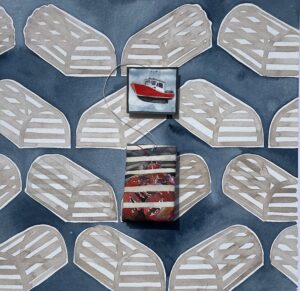
“I took the pattern and put objects that would be important to the lives of the people there into it,” she says. The tiny images include a rope, a lobster, a whale, a lighthouse, a chicken, and blueberries. These domestic elements, Nielsen notes, “add depth to the work, grounding it in the tangible while also hinting at deeper narratives and emotions beneath the surface.”
While concerns linked to our surroundings and the people living in them are at the heart of Harmon-Hay’s work as an artist, her themes are also a meditation on the complexity of our human experience.

“I have recently realized that my work is always based on a sense of loss,” she says. “In this time of uncertainty, from sending children off into the world, environmental changes, wars, elections and so on, it’s nice to feel tethered to what grounds us.”
Tethered
The event: Traci Harmon-Hay’s paintings of hovering objects
The time: May 24 through June 17
The place: Farm Projects, 355 Main St., Wellfleet
The cost: Free; $20 suggested donation
